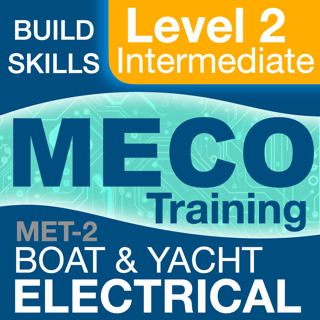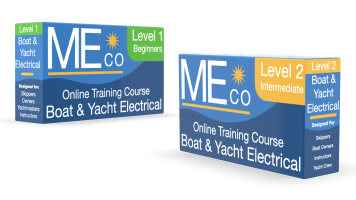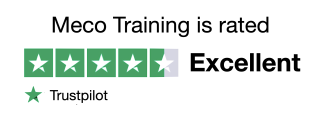MECO Boat & Yacht Electrical Course Level 2
The Meco Level 2 Boat & Yacht Electrical course studies the on-board electrical systems of a well equipped self sufficient ocean going live-aboard vessel. It is important that the basics from the level 1 course are thoroughly understood before embarking on the level 2 course, as these foundational elements will be built, and relied upon throughout.
Key points:
- Self paced, start training right away.
- Fully online, with full instructor support throughout.
- Learn the intricacies of the electrical system.
- Pre course requirements : B.Y.E Level 1 course
- Duration of course: Unlimited, you can take as long as you require.
Further Details:
The MECO training courses are aimed primarily at boat owners, skippers and crew, but many of our students enrol for pre study towards professional industry standard technician courses from the ABYC or BMEEA, or for super yacht crew studying towards IMO / MCA engineering courses.
The courses are designed to help you fully understand the on board electrical system, this begins to get fairly complex when we introduce multiple sources of AC power such as Shore-power, Generators, Inverters, and then to complicate matters further - multiple sources of DC power too, such as Solar, Wind, Alternators, and Battery chargers.
The overall electrical systems on a well equipped self sufficient vessel seems impossible to understand - when it's a mass of cables, how ever neatly it may be wired - this level 2 course serves to unravel the mystery by considering each and every circuit as an individual entity first, once that stage is understood, we then consider how this subsystem fits into the wider electrical system, what maintenance it needs, how it can fail, and how to find and fix faults. Each subsystem, however complex, is rendered down to its lowest basic requirements - volts, amps, and ohms.
What this course IS
How to fully understand the finer points of how marine electrical devices work, how they should be safely / legally / efficiently interconnected to work in harmony with each other, and how to prevent, find and fix faults. .
The Level 2 course covers the finer points of how each electrical subsystem works, but also covers the much wider topic of how they can be efficiently / legally / safely interfaced to work in harmony with the wider on board electrical system. Many How To guides use a one size fits all approach, this never works in the complex world of marine electrics! Each boat is different, each make, model, version of new kit is different, and it has to interface with various era's, makes and models of older equipment, the distance between the equipment plays a role in cable sizing, the size of the kit, how you use the vessel..... there are too many variables for a one size fits all approach to fitting marine equipment!
General ability after the course:
- Identify electrical potential dangers, and know when to call in the professionals,
- Hold a balanced conversation with engineers, technicians, and marine electricians
- Understand the finer points of how marine electrical devices work, and how they can fail
- Understand how key subsystems work in harmony with the wider electrical system
- Prevent, find and fix common basic electrical faults
- Evaluate how safe the electrical system is
- Identify key non conformances of the electrical system with reference to the relevant class, code, or standard
- Be able to make specific recommendations as to how the electrical system could be improved
- Evaluate an electrical system and build a spares wish list in priority order
- Decide what test equipment is required to carry on board based on the specific installation
Specific subjects covered during the course:
Syllabus
- Battery Rating
Methods
- Battery Standards
- Ah Rates in detail
- C Rates
- CCA Rates
- RC Rates
- Testing Batteries
- Bank Sizing
- Battery
Technology, Safety & Care
- Flooded Lead Acid
- Gel
- Valve Regulated Lead Acid
- Cycling
- Round trip efficiency
- Lithium Batteries
- Safety all batteries
- Battery preservation
- Battery
Charging
- Single Stage Charging
- Multistage
charging
- Bulk
- Absorption
- Float
- Voltage & Current during charging.
- C-Rates & Charging
- Limitations of Alternator charging
- DC Circuit
protection
- Discrimination
- Sizing
- Placement
- Trip characteristics
- Ratings
- Alternators -
External regulation
- Internal Regulation v External
- Single stage v Multi stage
- Voltage & current relationship
- Multiple
Alternators
- 2 Alternators on 1 engine
- Multi Engine / Multi battery methods
- Connecting multiple alternators
- Built in redundancy methods
- Solar
Power
- Introduction to solar
- Solar panel safety
- Solar Panel
Specifications explained
- ISC
- VOC
- Impp
- Vmpp
- Pmpp
- Solar Panel
recognised standards explained
- STC
- PVUSA
- Panel Technology
explained
- Mono Crystalline
- Poly Crystalline
- Panel
Wiring
- Parallel
- Series
- Controller
technology explained
- Pulse Width Modulation
- MPPT
- Placement of panels
- Interfacing with the vessels DC power Bus
- Interfacing with the vessels Data Bus
- Wind
Turbines
- Types
- How they work
- 3 phase alternator
- Phase current measurement
- Controllers
- Interfacing with the vessels power bus
- Interfacing with the vessels data bus
- AC Shore
power
- Introduction to
Alternating Current
- How AC is produced
- The 3 Phase systems
- Phase to phase voltages
- Single phase voltages
- Dangers of incorrect wiring
- The single phase conductors
- The 3 Phase Conductors
- Reverse
polarity
- Reverse polarity Dangers
- Detection of reverse polarity
- Correction of reverse polarity
- Earthing
- Reason for earthing
- Dangers of faulty earths
- How to identify faulty earth connection
- Introduction to
Alternating Current
- AC Circuit
protection
- Earth Leakage
- Electric Shock
Drowning
- Causes
- Methods of 100% prevention
- The
RCCB
- How it works
- Limitations
- Overcurrent
- The MCB
- Inverters
- Safety
- Sizing
- Voltage drop calculations
- Testing
- Ripple test
- Over current test
- Voltage drop test
- Earthing requirements
- Circuit protection DC
- Circuit protection AC
- Generators
- Safety
- Carbon Monoxide poisoning
- Fire
- Electrocution
- Flooding
- Types
- Synchronous
- Inverter
- Pre start checks
- Starting the generator
- Loading the generator
- Power factors
- Resistive loads
- Reactance
- Inductive Reactance
- Capacitive Reactance
- Apparent power
- Real Power
- Inrush currents
- Balancing loads
- Safety
- Galvanic action & Cathodic Protection
- Electron flow / Conventional Current flow
- Ion Flow
- Galvanic Scale
- The Sacrificial Anode
- Inter-boat galvanic action
- Bonding system
- The Galvanic Isolator
- Isolation Transformers
- Safety
- Why we need Isolation transformers
- How they work
- Electromagnetic induction process
- Losses
- Copper losses
- Eddie currents
- Efficiency
- Earthing arrangements
- Dangers of use on dry dock
- Electrolytic corrosion
- Nature of electrolytic corrosion
- Ferocity compared to galvanic corrosion
- Causes of Electrolytic corrosion.
- Prevention of Electrolytic corrosion
- Refrigeration
- The refrigeration process
- Adiabatic process
- Compressor function
- Condenser coil function
- Evaporator coil function
- Common causes of faults
- Voltage drop
- Gas loss
- Corrosion of terminals
- Faulty Condenser coil fan
- Diagnosis, fault finding
- Voltage drop test
- Current clamp test
- Fitting a diagnostic lamp
- Reading fault codes
- Increasing /Decreasing the cooling capacity
- Raising the speed of the compressor
- Raising the current draw
- Reducing the speed of the compressor
- Reducing the current draw
- The refrigeration process
- Water Makers
- How they work
- Safety
- Fault finding, testing
- Voltage drop test
- Poor connection checks
- Faulty Capacitors (AC systems)
- Current clamp test
- Modern technology versus old
- Energy recuperation
- VHF Radio
- Connections
- Power
- NMEA Data
- Coax Cabling
- The antenna
- Forward power
- Reflected power
- Standing waves
- Voltgae Standing Wave Reflections
- VSWR Testing
- Connections
- Course completion with optional written Exam




